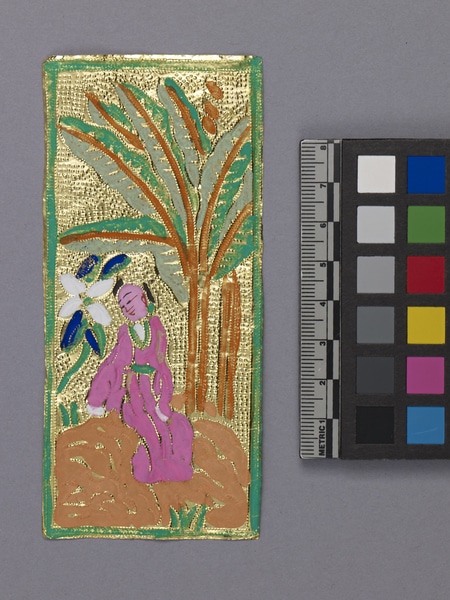Firecracker Label Item Number: 2905/13 from the MOA: University of British Columbia

Description
Rectangular label on rice paper backing with gold leaf background. A female figure wearing a pink robe is seated under a large tree on top of an orange hill. She is looking down to the left side of the image with a smile. There is a white flower on the left side as well.
History Of Use
Invented in China around the 12th century or earlier, firecrackers have been widely used in China to serve a variety of religious and secular purposes. In both the past and present, firecrackers are used to ward off evil spirits, to honour spirits and deities, and to mark special occasions such as weddings, birthdays, funerals, shop openings, or festivals. Firecrackers are by far in greatest demand during the annual Lunar New Year, when they are ignited to purify a space and to blast away negative energies and demons. Firecrackers are also used in “fengshui” geomantic practices, as ritual objects to be hung in the home to stimulate new beginnings, prosperity, and the protection of the household. A large number of gold firecracker labels were produced from approximately 1850-1910, in the Guangdong region of southern China, to decorate the wooden crates that they were shipped in. Since many of these were produced in Foshan (Fatshan), a city noted for its manufacture of handmade ritual goods, collectors often refer to them as “Fat Shan” labels. The characteristic "gold" effect is produced from bronze or copper sheets and gold leaf, and is recognized as a speciality of Foshan. They range in size from smaller four-inch squares to larger circular labels with a twenty-four inch diameter. The gold labels are colourfully painted with auspicious themes, including depictions of deities, legends and myths, historical narratives, and scenes of everyday life. The images enhance the fireworks’ role in dispelling evil while attracting virtue and prosperity. These gold labels were widely sold in south-central and south-west China, and south-east Asia. Local manufacturers and merchants would order bulk firecrackers, pack them into wooden crates, and decorate the crates with these labels to entice potential distributors and consumers. Aside from their use as firecracker labels, many people in south China used the labels to decorate their rooms and utensils. Few labels survived to today because of their fragility and the small value placed on them at the time. After 1910, these painstaking production techniques were gradually replaced by lithography machines, which allowed artisans to print full colour labels on rice paper.
Specific Techniques
Gold labels were handmade in workshops using assembly line techniques. Artisans first cut out the labels' overall shape from bronze or copper foil. Next, they apply a thin rice paper backing to strengthen the foil. To texturize the foil, the artisans used pointed tools to emboss designs. These sheets were pinned to a wall or table so that several painters could work on them. The backgrounds would be painted first, followed by the details in the foreground using smaller brushes. During the last application, even finer brushes were used for the facial features and calligraphy. Some shiny areas of the original bronze or copper foil were left exposed. It was also common to add a layer of gold leaf designs, pressed out of hand-carved wooden blocks, to further accentuate the design.
Iconographic Meaning
The image of fair maidens in a garden, a sign of beauty, fertility, and well-being, is a common theme in firecracker labels and Chinese popular art. This young maiden is dressed in an elegant robe, indicating her upper status. She likely had a coiffed bun on her head, but this has come off the surface of the gold foil. She is looking towards a white flower on the left, which appears to be a lily. Lilies have been grown in China since ancient times and are often associated with harmony, unity, and marital bliss. The Chinese name for lily (bai he) can be literally translated as “a hundred together,” a poetic reference to the layered petals that make up the bulb as well as the concept of bonded union. The maiden is sitting under what appears to be a large banana tree. Banana trees have long been common fixtures in Chinese gardens because of their lush foliage and the desirable sound of raindrops falling on its leaves. These sounds are said to bring tranquility and peace.
Item History
- Made in Foshan, Guangdong, China between 1850 and 1910
- Owned by Carol Potter Peckham before July 31, 2011
- Received from Carol Potter Peckham (Donor) on July 31, 2011
What
- Name
- Firecracker Label
- Identification Number
- 2905/13
- Type of Item
- label
- Overall
- height 12.6 cm, width 5.7 cm
Who
- Culture
- Chinese
- Previous Owner
- Carol Potter Peckham
- Received from
- Carol Potter Peckham (Donor)
Where
- Holding Institution
- MOA: University of British Columbia
- Made in
- Foshan, Guangdong, China
When
- Creation Date
- between 1850 and 1910
- Ownership Date
- before July 31, 2011
- Acquisition Date
- on July 31, 2011
Other
- Item Classes
- works on paper
- Condition
- excellent
- Accession Number
- 2905/0013